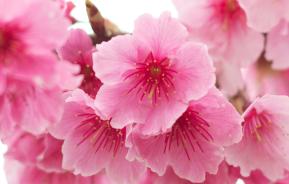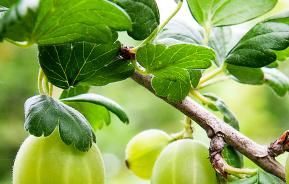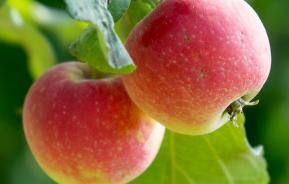Cherries are one of the best fresh fruit flavours of summer and they’re pretty easy to grow at home. Improvements and developments over recent years mean you don’t need a garden the size of an orchard to grow them or a ladder to pick them!
There are two main types. Sweet cherries (Prunus avium) produce delicious fruit that is eaten fresh, whereas acid or sour cherries (Prunus cerasus), as their name suggests, are more tart to be eaten raw and are used in cooking to make pies, puddings and preserves.
Fruiting cherries are also highly ornamental, producing delightful cherry blossom in spring. But there are also lots of fabulous flowering cherries grown purely for their ornamental blossom and foliage.
How to grow cherries
Cultivation
Sweet cherries need a warm, sunny site, which isn’t too exposed – strong winds can reduce pollination by bees, leading to a poor crop. As a result, they are often grown as a fan, trained up against a south-facing wall or fence.
Acid cherries tolerate some shade and are ideal for growing on a north-facing wall or fence.
Always plant out of frost pockets, which can affect the flowers and reduce pollination and so lead to a poor crop.
They prefer an alkaline to neutral fertile soil enriched with lots of organic matter, which holds plenty of moisture in spring and summer, doesn’t dry out but doesn’t become waterlogged. They dislike shallow and free-draining sandy soils.
Cherry varieties
There are numerous excellent sweet cherry varieties, but a more limited number of acid cherries.
Sweet cherry fruit skin varies in colour from yellow through red to dark red/ black. White-fleshed cherries are now very popular and generally much sweeter than the more typical pink-fleshed varieties.
If you only want to grow one sweet cherry tree, make sure you choose a variety that is self-fertile. Acid cherries are self-fertile.
Sweet cherries
The following are all superb self-fertile varieties:
- Celeste: Excellent early-season variety with dark red/black fruit.
- Early Rivers: Early, heavy crops of black fruit.
- Lapins: Black, glossy fruit for picking in late summer.
- Stardust:The first ever self-fertile, white-fleshed cherry producing substantial crops from the end of July with a long picking period.
- Stella: Large black fruit, Heavy crops for picking in July.
- Sunburst: Black fruit ready for picking in mid-summer.
Acid cherries
- Morello: Dark red fruit, heavy cropping, ready for picking in July and early August.
- Nabella: Large crops of juicy, black fruit ready to pick in late summer.

Pollination
Many cherry varieties need another different cherry variety that flowers at the same time to help pollinate it and produce good crops of fruit. The pollination requirements of non self-fertile cherries is quite complicated, and it is a better and easier choice to stick to self-fertile varieties, of which there are plenty.
Rootstocks
Cherry trees are available grafted onto different rootstocks, which control the overall size that the tree will grow to, as well as how early in their life they start fruiting. The most common ones are shown below. The eventual size will vary, depending on your soil; on heavy clay and fertile soils the trees will grow slightly bigger.
Sweet cherries are usually grafted onto the semi-vigorous Colt rootstock, which produces large trees growing to about 6-8m (20-27ft), but perfect for growing as fans.
Semi-dwarfing Gisela 5 and Tabel produce trees that reach 3-4m (10-13ft), making it the best choise for smaller gardens or for growing in containers.
Acid cherries are less vigorous than sweet varieties and only grow to a height of around 3-3.5m (10-12ft) when grown on Colt rootstock.
Planting cherries
Plant bare-root trees between November and March, and container-grown ones preferably in autumn or spring.
Dig a hole 60x60cm (2x2ft) and 30cm (12in) deep. Add a layer of organic matter - such as compost or well-rotted manure - to the base of the hole and dig in. Place the roots of the tree in the planting hole and adjust the planting depth so that the old soil mark on the trunk is level with the soil surface.
Now mix in more organic matter to the soil and fill in the planting hole. Stake the tree with a rigid tree stake and two tree ties so that it is fully supported against the prevailing winds. Water in well, apply a granular general feed over the soil around the tree and add a 5cm (2in) deep mulch of well-rotted garden compost or bark chippings around the root area.Large patio pots (minimum of 40-50cm/16-20in in diameter) can be used to grow cherries on semi-dwarfing rootstocks. Use John Innes No 3 Compost, as its weight will help with stability of the container.
How to care for cherries
Once established, cherry trees are unlikely to need regular watering, except in very dry conditions, but may need watering when the fruit is developing to help ensure a bumper crop. But avoid watering prior to picking as this can cause the skin to split.
Trees growing in containers, however, will need regular watering in spring and summer to prevent the compost drying out.
Add a granular plant food to the soil surface each spring to ensure the tree is fed throughout the growing season. Trees that produce poor crops of fruit will benefit from feeding with sulphate of potash.
Cherry flowers can be susceptible to frost damage, so wherever practical cover with horticultural fleece when frost is predicted.
Pruning
If you buy a fully trained cherry tree it will need little in the way of pruning for the first few years at least.
Pruning must always be carried out when the tree is in full growth – usually any time from May to the end of August. Pruning at other times of year risks infections from disease – particularly bacterial canker, which can kill even fully grown trees.
It pays to know what, how and why you’re pruning, as wrong or excessive pruning can lead to crop reduction. Most times all you need to do is remove dead, diseased, dying or damaged branches, branches that rub against each other and those that cross from one side of the tree to another.
If you constantly have to prune the top of the tree to reduce its height, then you’ve probably bought one growing on the wrong rootstock!
Sweet cherries
Sweet cherries fruit on one-year-old and older wood. The aim of pruning is to remove some of the oldest wood and so replacing it with new growth that will produce a crop the following year.
Acid cherries
Acid cherries bear nearly all their fruit on the previous year’s growth.
Free-standing trees Remove one in four or five of the oldest fruited shoots, pruning to a younger sideshoot.
Fans Prune back branches growing away from the wall to two to three leaves. Prune back fruited shoots to a suitable sideshoot to replace the removed shoot.
Harvesting
Pick the fruit once it has developed a good colour, but before it turns too soft, holding it by the stalk, not the fruit itself, which bruises easily. Picking is best done during dry weather.
Sweet cherries are best eaten fresh, but can be stored in the fridge in a plastic bag for up to 7-10 days.
| Flowering season(s) | Spring |
|---|---|
| Foliage season(s) | Spring, Summer, Autumn |
| Sunlight | Full shade, Partial shade, Full sun |
| Soil type | Chalky, Clay, Loamy |
| Soil pH | Alkaline |
| Soil moisture | Moist but well-drained |
| Ultimate height | Up to 8m (26ft) depending on rootstock |
| Ultimate spread | Up to 5m (16ft) depending on rootstock |
| Time to ultimate height | 10-15 years |








